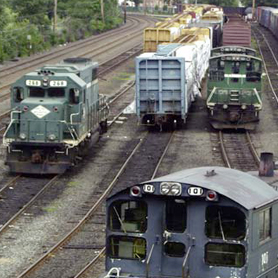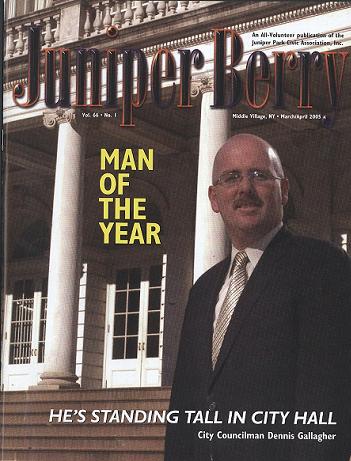Without question, we do not need the Cross Harbor Freight Rail Tunnel, but, we do need the freight rail infrastructure upgraded to 21st Century standards. For example, when I look at the rusted rails and bridges and
the more than fifty year old signal systems being used on our railroads it reminds me of the lyrics in that famous Johnny Cash song The Wabash Cannon Ball, “listen to the rattle and the rumble and the roar, listen to the whistle of The Wabash Cannon Ball”. Yes, when I was a young boy during World War II, I rode on the LIRR to lake Ronkonkoma with the soldiers headed out to Yaphank and the coal fired steam engine did indeed rattle and roar, and there was only one track between Pine lawn and Wyandanch. Well, in those days, Ronkonkoma was almost the end of the world and nobody ever conceived a man standing on the Moon; what I can’t conceive today is that there is still ONLY one track between Pine Lawn and Wyandanch – hello MTA anybody home!
On Monday, February 7, 2005, several members of the Juniper Park Civic Association and Community Board Q5 were invited to attend a public hearing on the Cross Harbor Freight Tunnel held by Community Board 14 Brooklyn. Much to our surprise, Congressman Jerrold Nadler was present and when it was his turn to speak, he said, that those in opposition to the tunnel were spreading lies and miss-statements about the project and that if we did not accept a tunnel none of the associated improvements would be possible. Actually, that was the only incorrect statement that evening.
Clearly, the reason we don’t need the Cross Harbor Freight Tunnel is that the rail network east of the Hudson is joined to the national rail network at Selkirk New York. The main rail line network heads out of Chicago across the Great Lakes and into Selkirk. Incidentally, one of the largest freight rail yards east of the Mississippi is located at Selkirk New York. In addition, rail freight leaving Montreal Canada is linked to Selkirk New York. It is at this rail juncture that freight is sent down the west side or the east side of the Hudson River, consequently, there is no need for a Cross Harbor Freight Tunnel.
However, as we move into the 21st Century there is an urgent need to up-grade the rail infrastructure east of the Hudson River.
The following statistics underscore the need to immediately address this issue with practical and prudent spending of the taxpayer’s money.
Bigger trucks tear up the highway infrastructure. Heavy trucks are responsible for a disproportionate amount of pavement damage: one 80,000 pound five-axle truck does as much damage as 9,600 cars.
Adding weight to the same truck will sharply escalate pavement damage: at 100,000 pounds, the truck will do as
much damage as 27,000 cars. (Note: adding axles to a truck – including long double and triple trailer trucks – ameliorates pavement damage.) (AASHTO Pavement Design Guide)
Bigger trucks will cause a massive increase in bridge costs. Longer combination vehicles – long double and triple trailer trucks – will cost the country $319 billion in bridge costs ($53 billion in capital and $266 billion
in user delay costs). (US DOT 2000 Comprehensive Truck Size and Weight Study)
Even without building new highways, the US will need to spend $56.6 billion per year simply to maintain the condition of the current bridge and highway system. (US DOT 1999 Status Report on the Nation’s Surface Transportation
System)
• Railroads are on average three times
as fuel efficient as trucks. This means
that trains can move a ton of freight
three times as far as trucks per gallon
of fuel used.
• Railroad fuel efficiency has increased
61 percent since 1980; today railroads
can move a ton of freight an average of
379 miles on each gallon of diesel fuel
used.
• The U.S. Environmental Protection
Agency has stated that locomotives are
about three times cleaners than trucks
based on air emissions per ton moved.
• Over the past five years, railroads
have invested several billion dollars to
acquire more than 3,500 locomotives
that are more fuel-efficient and less
polluting than older models.
Railroads have committed themselves
to further substantial reductions in
atmospheric emissions. The industry has
tentatively endorsed an Environmental
Protection Agency proposal that calls
for a 60 percent reduction in noxious
emission on new locomotives manufactured
beginning in 2005.
In view of the obvious energy efficiency and improved air quality that rail freight has over truck traffic, it is
incredible that the MTA has not granted our regional rail freight carrier the New York & Atlantic Rail Road the right to handle 286,000 lbs. cars in lieu of the 263,000 lbs. cars that it currently handles. In additions, since a study has been completed over the entire LIRR that indicates exactly what must be done to accommodate the “Plate F” railcars, the New York & Atlantic Rail Road should be granted route clearance for “ Plate F” railcars in the short term, with LIRR system wide clearance long term. Considering that both these request are of negligible cost and would remove thousands of trucks from our local highways – why have they not been granted.
As we comprehend the comparison between the two different modes of freight delivery, it is difficult to conceive how our elected officials and government as a whole have put us in a position where a 53 ft trailer is making deliveries to our local grocery store.
The drivers can’t negotiate our local streets without damaging signal poles or vehicles, needless to mention the
damage to the local roads that were never designed to carry very heavy trucks. It is incumbent upon city, state and the federal government to design and implement a master plan for the efficient delivery of goods throughout the Greater New York Metropolitan Area. And, it is incumbent upon all
New Yorkers to elect officials who will work towards that goal.




